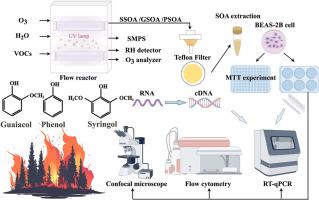Secondary organic aerosol from biomass burning intermediates induced significant oxidative stress in human lung epithelial cells
IF 3.4
Q2 ENVIRONMENTAL SCIENCES
引用次数: 0
Abstract
Phenol and methoxyphenols are key semi-volatile compounds released from biomass burning with great potential in forming secondary organic aerosol (SOA), threatening global climate and public health. However, the underlying toxicity mechanisms of SOA from biomass burning (BBSOA) remain poorly understood. A detailed examination of the chemical composition and in vitro exposure were performed to comprehensively understand the oxidative stress effects of BBSOA on human bronchial epithelial (BEAS-2B) cells. Oxidative damage and inflammatory responses of the cells following exposure to SOA from phenol (PSOA), guaiacol (GSOA), and syringol (SSOA) were evaluated. Exposure to BBSOA resulted in a noticeable reduction in cell viability, marked by a significantly increased apoptosis in BEAS-2B cells. Flow cytometry and confocal image analysis revealed significant increases in reactive oxygen species (ROS), indicating mitochondrial stress in vitro. The oxidative stress effect from PSOA was observed to be the most significant among all the three types of BBSOA. Using PSOA as a model system, RT-qPCR and RNA-sequencing confirmed that BBSOA induces the upregulation of typical oxidative stress genes, such as NQO1, HMOX1, and ALDH1A3, resulting in cell death. From acellular oxidative potential to cellular transcriptomic level, this work provided direct evidence on the oxidative stress effects from BBSOA, highlighting the health impacts of secondary biomass burning aerosol during regional transportation.

生物质燃烧中间体产生的二次有机气溶胶诱导人肺上皮细胞显著氧化应激
苯酚和甲氧基酚是生物质燃烧释放的重要半挥发性化合物,具有形成二次有机气溶胶(SOA)的巨大潜力,威胁着全球气候和公众健康。然而,生物质燃烧(BBSOA)的潜在毒性机制仍然知之甚少。为了全面了解BBSOA对人支气管上皮细胞(BEAS-2B)氧化应激的影响,我们对BBSOA的化学成分和体外暴露进行了详细的研究。我们评估了暴露于酚(PSOA)、愈创木酚(GSOA)和丁香酚(SSOA)中SOA后细胞的氧化损伤和炎症反应。暴露于BBSOA导致细胞活力明显降低,其标志是BEAS-2B细胞的凋亡显著增加。流式细胞术和共聚焦图像分析显示活性氧(ROS)显著增加,表明线粒体在体外应激。三种类型的BBSOA中,PSOA的氧化应激效应最为显著。以PSOA为模型系统,RT-qPCR和rna测序证实,BBSOA诱导NQO1、HMOX1、ALDH1A3等典型氧化应激基因上调,导致细胞死亡。从胞外氧化电位到细胞转录组水平,本研究为BBSOA的氧化应激效应提供了直接证据,突出了生物质二次燃烧气溶胶在区域运输过程中的健康影响。
本文章由计算机程序翻译,如有差异,请以英文原文为准。
求助全文
约1分钟内获得全文
求助全文
来源期刊

Atmospheric Environment: X
Environmental Science-Environmental Science (all)
CiteScore
8.00
自引率
0.00%
发文量
47
审稿时长
12 weeks
 求助内容:
求助内容: 应助结果提醒方式:
应助结果提醒方式:


